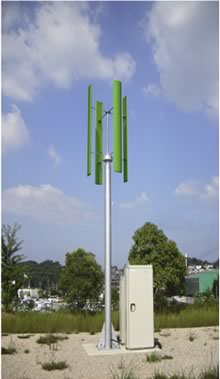1kW Power Generation System for Auxiliary Power (for interconnected system)

Wind Power Generator
| Type of generator | NKC-1000-200 | ||
| Output at 13 m/s | 1000W | ||
| Nominal output | 1180W (3 phase, AC) |
||
| Output voltage | AC 220V | ||
| Start-up wind speed | 0.8m/s | ||
| Start-of-charge wind speed | 2.0m/s | ||
| Survival wind speed (maximum instantaneous wind speed) | 60m/s | ||
| Brake | Electric brake | ||
| Rotor diameter | φ1500mm | ||
|
2500mm
300mm 4 Aluminum alloy (A5052) Anti-rust/anti- Urethane resin paint finish Yellow Green |
||
|
Structural carbon steel tube/sheetHot-dip galvanizedUrethane resin paint finish coatingSilver gray Munsell: N8.0~8.5 JPMA: CN-80 to 85 |
||
| Height | Approx. 6,820 mm | ||
| Approximate weight | 500kg | ||
| Note:This Product Specification is as of Sep.2008. It would be changed due to our certain reasons without prior announcement. | |||
Summary
This wind power generation system is connected to an existing power system using a power conditioner. It therefore has no battery and cannot be used without a power grid. If you want freestanding load operation that uses a battery or other storage system, please choose a different series.
The power output through the power conditioner is single-phase three-wire 100/200V (50/60Hz). A power conditioner is available for those who wish to have triple-phase output. Please inquire.
Performance
- Interconnected System
The power generated by the wind turbine generator is converted from AC to DC by a rectifier, and is boosted to the power conditioner’s operating voltage by a DC/DC converter. The boosted power is converted from DC to single-phase three-wire AC (100/200V) by the power conditioner, and is interconnected to an existing power grid and used as ordinary commercial electricity.
Both the DC/DC converter and power conditioner have power load adjustment on both the input and output ends to supply power to the grid that matches the wind speed.
- Brake System
This is an electrical brake system that controls rotation when the wind speed exceeds the system’s rated rotation speed in order to continue generating power.
When the turbine rotates faster than its rated speed due to sudden changes in wind speed such as gusts, the signal from the voltage detector (VD) causes the electrical brake to operate, thereby decreasing the rotation. When the turbine’s rotation drops below its rated speed, the electrical brake is automatically released.
For maintenance, the electrical brake can also be applied manually to stop operation.


(+66) 02-236-3102
[email protected]